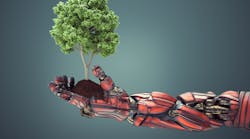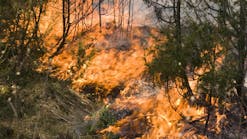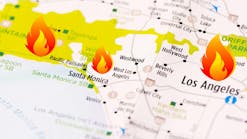Is there such a thing as a casual observer when it comes to vegetation management? Probably not! It’s one of those subjects that everyone has a strong opinion, and the opinions run from conservative to liberal. There is, however, one commonality – all are demanding improvements. Why may you ask yourself? Because of vegetation management’s relationship with power outages and grid resiliency has been made more complicated wildfires.
There probably isn’t a casual observer when it comes to artificial intelligence (AI) either. As AI becomes more autonomous, it’s raising strong opinions too. It’s a concept that little attention is given. Most of our attention has been focused on driver-less vehicles. Many are concerned that the more autonomous AI becomes, the less humans will understand it and how it works, which will make it harder to control. Another worry is about AI controlled machines replacing humans.
AI Improves
To be autonomous the AI application needs analytical capabilities that allow it to operate independently from human control. To be clear, AI technology hasn’t progressed as far as the science fiction seen in Marvel Universe. Today’s autonomous AI is a specialized version of narrow AI or more specifically machine learning. AI’s decision-making is controlled by algorithms or series of algorithms that are capable of analyzing the enormous amounts of big-data supplied by sophisticated remote sensing technologies used in systems like vegetation management.
This analysis is invaluable when it comes to finding patterns and specific information in the raw bigger-data common today, which is exactly what today’s vegetation management needs. Like all of the current technology wearing the autonomous AI label, it needs some form of human guidance, but it’s minimal compared to earlier generations. Suppliers such as AiDash, GE, Hitachi, IBM, Siemens Energy, and others are saying more intelligent platforms will revolutionize vegetation management. Opponents ask, is autonomous AI technology the answer?
Before answering that question let’s look a little closer at what’s taking place on the electrical power grid. Everyone is aware that there has been an upswing in electrical power outages, but why is that? Some critics say it’s the way utilities are going about vegetation management. They are not being aggressive enough when it comes to clearing rights-of-ways (ROW), which is an obvious simplification that ignores a lot of collected data.
What’s Up
Digging into the issue revealed that extreme weather events have changed the playing field when it comes to vegetation management. Risks are no longer confined to the vegetation along the power line rights-of-way (ROW), but go beyond the ROW. What once worked is no longer sufficient with extreme weather conditions on the rise globally. Climate change has worsened power outages! It’s hammering the power delivery system with a recurring series of once-in-a-lifetime storms that the grid was never designed or constructed to handle.
Compounding the problem are vegetation management strategies intended for a normalcy that no longer exists. Also utilities have regulatory requirements to survey their transmission systems every year, but the interpretation all of the big-data takes time, so it is prioritized. That doesn’t mean the data is ignored, but given the enormity of the transmission circuit miles, it encourages time-based maintenance cycles for known problem areas, but how many miles are we discussing?
On a global scale that’s a hard question to answer due to many factors, but North America is better documented. It’s estimated there are about 200,000 miles (321,000 km) of high-voltage transmission lines. If distribution lines are included, somewhere around 5.5 million circuit miles (8.8 million km), which is reasonable because most authorities agree that the majority of interruption happen on the distribution system.
Spending’s Up
Circuit miles are meaningless to the customers. They’re only interested in keeping their lights on, and utilities are working hard to reduce those power outages. A recent study from Fortune Business Insights points out that globally utilities and grid operators spent US$24.28 billion in 2022 on vegetation management. Forbes continued saying they expect that spending to reach US$39.27 billion by 2029. Several other authorities report that vegetation management is the largest expenditure in the average utility’s yearly operating budget, but it’s not working because outages are on the rise.
That brings us to climate change and its impact on the environment, which has been defined as the major cause of electrical power outages. Supporting this statement is new SAIDI data from the U.S. Energy Information Administration (EIA). SAIDI is a reliability metrics and stands for the “System Average Interruption Duration Index.” The EIA recently published its “Electric Power Annual 2021” in November, 2022 (Editor’s note - the latest figures available).
One section was a real attention magnet. It focused specifically on power outages in 2021. EIA’s data determined that the average U.S. electricity customer experienced just over seven hours of SAIDI defined power outages. The seven hour period represent all interruption events in 2021, but there is more. Reading further revealed that about five hours of the total seven hours, or approximately 71%, were attributed to major weather-related events.
It’s Complicated
While there wasn’t any further information defining those causes of the 71% of interruptions, it shows how complicated vegetation managing has become with the influence of extreme weather in the equation. That’s why relying on legacy vegetation management and asset inspection approaches such as fixed cycle surveys, rotational trimming, and ground crew inspections aren’t having much effect on reducing outages. Even those who have added drones, helicopters, and other aerial platforms aren’t seeing improvement in outage numbers.
Things improve somewhat for those taking the leap to vegetation management platforms utilizing LiDAR (light detection and ranging) and photogrammetry. Satellite technology provide continuous surveying of a utility’s territory with multispectral, and hyperspectral technologies. Multispectral and hyperspectral imaging gather data from multiple bands across the electromagnetic spectrum – most of which cannot be seen by the human eye.
What makes this noteworthy is the data cube these applications provide to 21st century vegetation management platforms. With this technology, the platform can tell the health of the plant life and type of tree found along any ROW and adjacent terrain. That is why it’s an important advantage of all the state-of-the-art surveying and asset inspection technologies available to the vegetation managers and their teams, but there are drawbacks.
These cutting-edge applications generate terabytes of this bigger-data, which must be analyzed, or important information can be missed. That is why integrating vegetation management platforms with autonomous AI is important. They are designed to sift through all data sources and identify risks before they become dangerous. When that is combined with digital twin technology it is seen as being transformational.
Without going to deeply, digital twins are a virtual representation of a physical asset. This representation is a model and utilities have used LiDAR for years to develop detailed digital models of their transmission lines and distribution circuits. At the same time, all of the plant life on and to the sides of the ROWs have been developed too. Spectrum imaging has taken the detail to the tree level identifying the species, growth patterns, soil conditions. and more.
With all of this existing data, combining digital twin virtual technology with vegetation management and enhanced AI applications is the next logical step in the process. The digital shows everything power line modeling is famous for plus the plant life under, along, and beside the ROWs. This version of the digital twin systems include the environment with the power line, and it can be linked with real-time weather conditions.
The AI enhanced digital twin can measure plant growth, soil moisture, and tree health. It also classifies a tree’s threat level (i.e., low, medium, and high) based on a variety of power line characteristics. Taking it a step further, platforms can run simulations based on predicted weather patterns and a range of power line loading criteria and predict trouble spots many months in advance. This risk analysis can identify problem areas with sufficient time for the utility to take action and remove the outage hazards.
This may sound like science fiction, but the technology exists, and it’s used by utilities today, but not all of the applications offered are equal. It’s one of those applications that are called an emerging technology and it’s important to do your homework when specifying the platform.
The abilities of these systems vary due to their cost, how they are expected to be used, and how they are specified. Some are what is called an “end-to-end intelligent suite” that include everything from automated hazard identification to hiring trimmers to remove those trouble-trees. Some systems may specialize in data analysis, while others fall somewhere in the middle. Last March “Charging Ahead” talked about how change is exponential, which tends to make everyone extremely uncomfortable. Vegetation management technologies enhanced with autonomous AI definitely fit into that category, but it has a lot going for it when it comes to reducing power outages!


